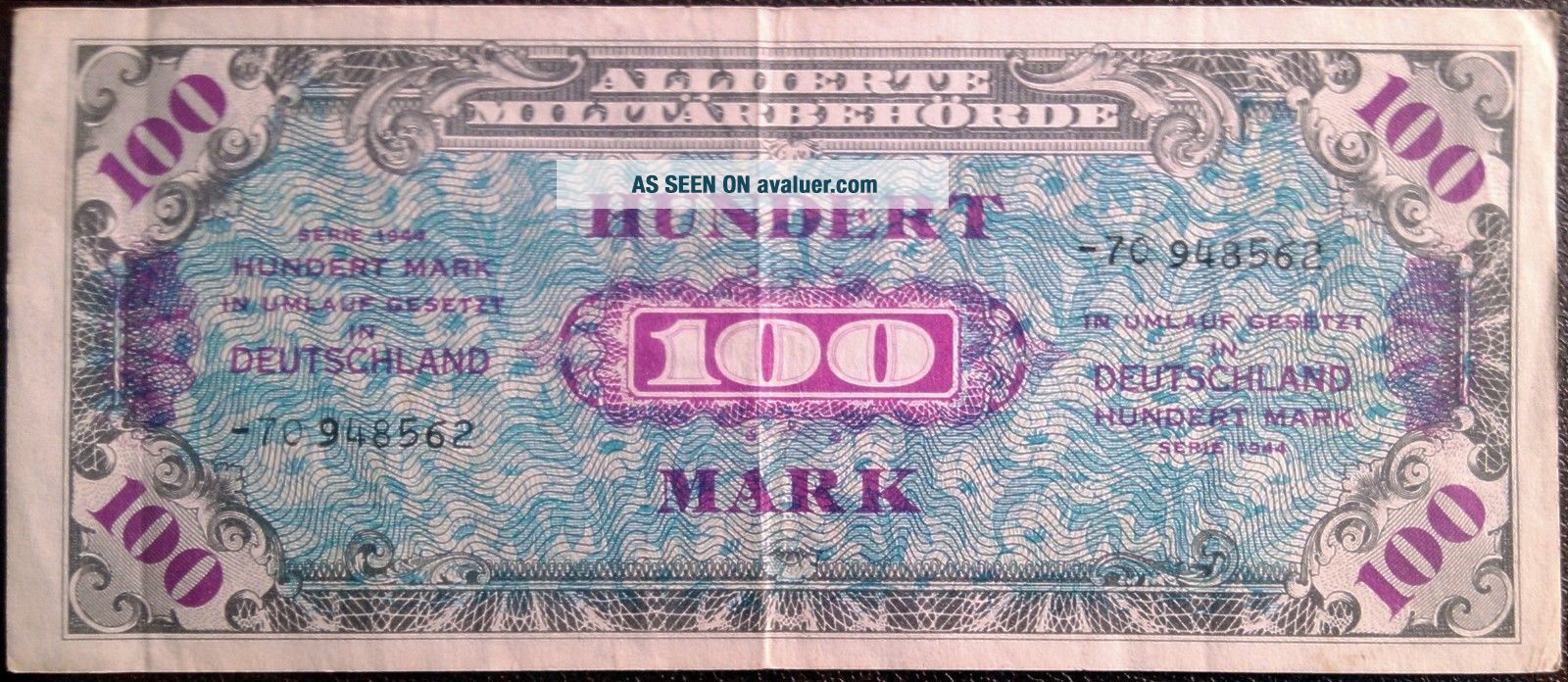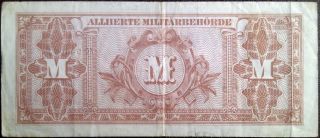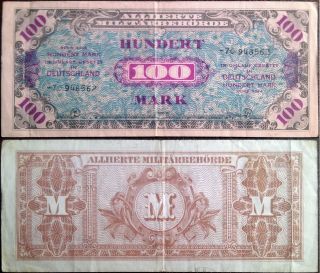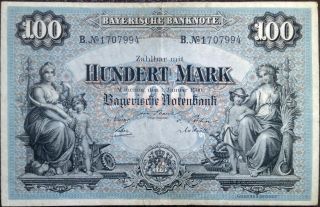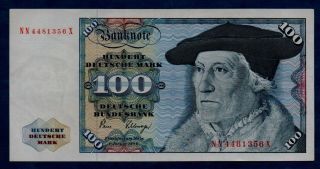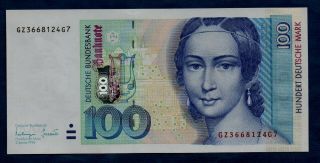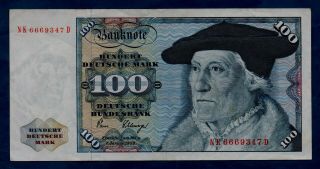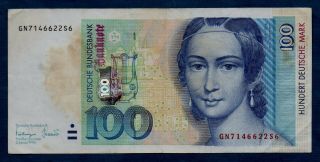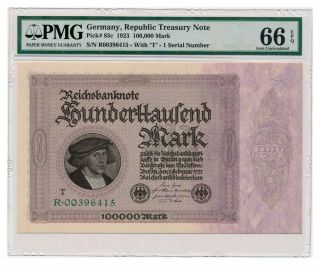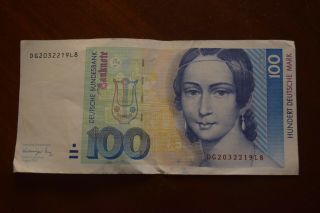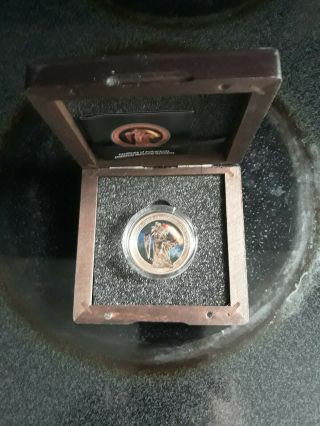Nazi Germany Banknote - 100 Hundert Mark - Year 1944 - Allied Military Currency
Item History & Price
| Reference Number: Avaluer:10305159 | Type: Banknotes |
| Circulated/Uncirculated: Circulated | Country: Germany |
| Country/Region of Manufacture: Germany | Certification: Uncertified |
SEE MY OTHER AUCTIONS
FREE SHIPPING WORLDWIDE
IF YOU ARE SATISFIED WITH SERVICE, PLEASE LEAVE US A POSITIVE FEEDBACK
HAVE A GOOD LUCK!!!
Reichsmark was the currency in Germany from 1924 until 20 June 1948 and in Austria from 1938 to 1945. The Reichsmark was subdivided into 100 Reichspfennig. The Mark is an ancient Germanic weight measure, traditionally a half pound, later used for several coins. From 1871 to 1918 Germany was called the Kaiserreich or the Deu...tsches Reich. Although Germany became a republic in 1919, the term "Reich" remained part of the country's official name.
The Reichsmark was introduced in 1924 as a permanent replacement for the Papiermark. This was necessary due to the 1920s German inflation which had reached its peak in 1923. The exchange rate between the old Papiermark and the Reichsmark was 1 ℛℳ = 1012 Papiermark (one trillion in both UK and US English, one billion in German and other European languages, see long and short scales). To stabilize the economy and to smooth the transition, the Papiermark was not directly replaced by the Reichsmark, but by the Rentenmark, an interim currency backed by the Deutsche Rentenbank, owning industrial and agricultural real estate assets. The Reichsmark was put on the gold standard at the rate previously used by the Goldmark, with the U.S. dollar worth 4.2 ℛℳ.
With the unification of Germany and Austria in 1938, the Reichsmark replaced the Schilling in Austria. During the Second World War, Germany established fixed exchange rates between the Reichsmark and the currencies of the occupied and allied countries, often set so as to give the Germans economic benefits.
The AM-Mark (Allied-Military Currency) was the currency issued in Allied-occupied Germany by AMGOT after the commencement of Operation Wild Dog in 1944.
Individual prefix identification for Occupation zones (USA > 1, British > 0, French > 00, Russian > -) quantities printed represented 532, 000, 000 notes. These notes circulated through mid 1948. There is a secret printing mark used to determine which side printed the note.
Military currency and occupation money are money provided for the use of military personnel serving in occupied territory. Depending on circumstances, military currency can be provided by an aggressor or a liberator and take a variety of forms for use by military and / or local populations. In the case of Hawaii in World War II military currency was swapped for the US dollars on the island in preparation for a possible Japanese invasion. This pre-empted the possibility of Japan gaining control of all the US dollars in Hawaii since ‘greenbacks’ were internationally negotiable. -ie accepted in most countries and so potentially an economic windfall to Japan. Many countries including Japan, Germany, Austria, The United States of America, and Britain have produced military currency during conflicts between World War II and Vietnam. The equivalent to military currency now used by military personnel serving overseas is the value-added charge card.
Military Currencies are issued strictly for the use of troops serving overseas; they are prepared by a (military) power or Government and declared by the overall commander to be legal tender for use by civilian and/or military personnel as prescribed in the areas occupied by its forces . ‘Military Currency’ should be of a distinctive design so as to be able to distinguish it from the national (i.e. official) currency of the country concerned, but it may be denominated in the monetary unit of either .
Historically, soldiers serving overseas had been paid in local currency rather than in their “home” currency; most cash drawn by soldiers would go directly into the local economy, and in a damaged economy the effects of a hard currency such as the dollar circulating freely alongside weaker local currencies could be severely problematic, risking severe inflation. There were other problems as well; once dollars were circulating in a combat region, the opposing side could freely use its own stocks of dollars as currency, or acquire stocks for use elsewhere. The high purchasing power of the dollar, and its easy transference back to the United States, also posed a significant incentive to black-marketeering.
However, whilst the use of local currencies was effective where they were provided in cooperation with the local authorities, it was impractical in combat zones where the government might be either hostile, deliberately ambivalent, or simply non-existent. In these cases, the military authorities issued special “military currency”, which was paid out to soldiers at a fixed rate of exchanged and simply declared legal tender in occupied areas by local commanders.
Allied Military Currency was issued for use in Italy, France, Germany, Japan and for a short time in Korea, Denmark and Austria. Some of these currencies saw service in other parts of the world as well. As a general rule, the use of this currency was in response to local Black Market activity and the associated need to stabilize the local economy. They were issued for use by military personnel only and generally on base only. In some cases the civilian population would accept these notes for goods or service and discover that they could not exchange them for the local currency. Many soldiers brought these notes home as mementos and now seventy years later they are collectible as a part of military history.
Source: Wikipedia
FREE SHIPPING WORLDWIDE
IF YOU ARE SATISFIED WITH SERVICE, PLEASE LEAVE US A POSITIVE FEEDBACK
HAVE A GOOD LUCK!!!
Reichsmark was the currency in Germany from 1924 until 20 June 1948 and in Austria from 1938 to 1945. The Reichsmark was subdivided into 100 Reichspfennig. The Mark is an ancient Germanic weight measure, traditionally a half pound, later used for several coins. From 1871 to 1918 Germany was called the Kaiserreich or the Deu...tsches Reich. Although Germany became a republic in 1919, the term "Reich" remained part of the country's official name.
The Reichsmark was introduced in 1924 as a permanent replacement for the Papiermark. This was necessary due to the 1920s German inflation which had reached its peak in 1923. The exchange rate between the old Papiermark and the Reichsmark was 1 ℛℳ = 1012 Papiermark (one trillion in both UK and US English, one billion in German and other European languages, see long and short scales). To stabilize the economy and to smooth the transition, the Papiermark was not directly replaced by the Reichsmark, but by the Rentenmark, an interim currency backed by the Deutsche Rentenbank, owning industrial and agricultural real estate assets. The Reichsmark was put on the gold standard at the rate previously used by the Goldmark, with the U.S. dollar worth 4.2 ℛℳ.
With the unification of Germany and Austria in 1938, the Reichsmark replaced the Schilling in Austria. During the Second World War, Germany established fixed exchange rates between the Reichsmark and the currencies of the occupied and allied countries, often set so as to give the Germans economic benefits.
The AM-Mark (Allied-Military Currency) was the currency issued in Allied-occupied Germany by AMGOT after the commencement of Operation Wild Dog in 1944.
Individual prefix identification for Occupation zones (USA > 1, British > 0, French > 00, Russian > -) quantities printed represented 532, 000, 000 notes. These notes circulated through mid 1948. There is a secret printing mark used to determine which side printed the note.
Military currency and occupation money are money provided for the use of military personnel serving in occupied territory. Depending on circumstances, military currency can be provided by an aggressor or a liberator and take a variety of forms for use by military and / or local populations. In the case of Hawaii in World War II military currency was swapped for the US dollars on the island in preparation for a possible Japanese invasion. This pre-empted the possibility of Japan gaining control of all the US dollars in Hawaii since ‘greenbacks’ were internationally negotiable. -ie accepted in most countries and so potentially an economic windfall to Japan. Many countries including Japan, Germany, Austria, The United States of America, and Britain have produced military currency during conflicts between World War II and Vietnam. The equivalent to military currency now used by military personnel serving overseas is the value-added charge card.
Military Currencies are issued strictly for the use of troops serving overseas; they are prepared by a (military) power or Government and declared by the overall commander to be legal tender for use by civilian and/or military personnel as prescribed in the areas occupied by its forces . ‘Military Currency’ should be of a distinctive design so as to be able to distinguish it from the national (i.e. official) currency of the country concerned, but it may be denominated in the monetary unit of either .
Historically, soldiers serving overseas had been paid in local currency rather than in their “home” currency; most cash drawn by soldiers would go directly into the local economy, and in a damaged economy the effects of a hard currency such as the dollar circulating freely alongside weaker local currencies could be severely problematic, risking severe inflation. There were other problems as well; once dollars were circulating in a combat region, the opposing side could freely use its own stocks of dollars as currency, or acquire stocks for use elsewhere. The high purchasing power of the dollar, and its easy transference back to the United States, also posed a significant incentive to black-marketeering.
However, whilst the use of local currencies was effective where they were provided in cooperation with the local authorities, it was impractical in combat zones where the government might be either hostile, deliberately ambivalent, or simply non-existent. In these cases, the military authorities issued special “military currency”, which was paid out to soldiers at a fixed rate of exchanged and simply declared legal tender in occupied areas by local commanders.
Allied Military Currency was issued for use in Italy, France, Germany, Japan and for a short time in Korea, Denmark and Austria. Some of these currencies saw service in other parts of the world as well. As a general rule, the use of this currency was in response to local Black Market activity and the associated need to stabilize the local economy. They were issued for use by military personnel only and generally on base only. In some cases the civilian population would accept these notes for goods or service and discover that they could not exchange them for the local currency. Many soldiers brought these notes home as mementos and now seventy years later they are collectible as a part of military history.
Source: Wikipedia



